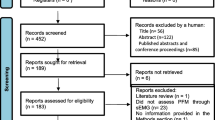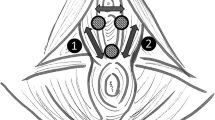Abstract
Purpose
Surface electromyography (sEMG) using intravaginal probes is of widespread use for assessing pelvic floor muscles (PFM) activity in women. Although considered as a reliable method, its validity has been called into question due to the presence of a phenomenon called crosstalk. Crosstalk is described as the recording of sEMG activity originating from neighboring muscles rather than coming exclusively from the muscles being investigated. The purpose of this review was to provide an overview of existing literature about crosstalk during intravaginal surface electromyographic recordings.
Methods
A scoping review was performed according to the Arksey and O’Malley framework. An electronic search was conducted on six relevant databases. Additionally, authors were directly contacted to identify grey literature. Data extraction consisted of descriptive numeric analysis as well as thematic analysis, which were conducted by two independent reviewers.
Results
Forty-nine references written by 34 authors coming from 13 different countries constitute the body of evidence of the present review. Eight main themes have been identified through the thematic analysis. The included material varies greatly in terms of methodology, approach to the crosstalk problem and depth of analysis.
Conclusions
A gap in knowledge affecting the validity of the current sEMG investigation methods was identified. Literature addressing the crosstalk problem is scarce and often flawed. Definitive conclusions are regularly drawn from an insufficient basis of evidence. Further research is, therefore, deeply necessary, although it remains unclear whether this issue can be solved at all with current technology.

Similar content being viewed by others
References
Luginbuehl H, Greter C, Gruenenfelder D, Baeyens JP, Kuhn A, Radlinger L (2013) Intra-session test-retest reliability of pelvic floor muscle electromyography during running. Int Urogynecol J 24(9):1515–1522. doi:10.1007/s00192-012-2034-2
Brown CC (2007) Reliability of electromyography detection systems for the pelvic floor muscles. Master’s thesis. Queen’s University, Kingston
Grape HH, Dedering A, Jonasson AF (2009) Retest reliability of surface electromyography on the pelvic floor muscles. Neurourol Urodyn 28(5):395–399. doi:10.1002/nau.20648
Keshwani N, McLean L (2013) A differential suction electrode for recording electromyographic activity from the pelvic floor muscles: crosstalk evaluation. J Electromyogr Kinesiol 23(2):311–318. doi:10.1016/j.jelekin.2012.10.016
Turker KS (1993) Electromyography: some methodological problems and issues. Phys Ther 73(10):698–710
De Luca CJ (1997) The use of surface electromyography in biomechanics. J Appl Biomech 13:135–163
Byrne CA, Lyons GM, Donnelly AE, O’Keeffe DT, Hermens H, Nene A (2005) Rectus femoris surface myoelectric signal cross-talk during static contractions. J Electromyogr Kinesiol 15(6):564–575. doi:10.1016/j.jelekin.2005.03.002
Solomonow M, Baratta R, Bernardi M, Zhou B, Lu Y, Zhu M, Acierno S (1994) Surface and wire EMG crosstalk in neighbouring muscles. J Electromyogr Kinesiol 4(3):131–142. doi:10.1016/1050-6411(94)90014-0
Luginbuehl H, Naeff R, Zahnd A, Baeyens JP, Kuhn A, Radlinger L (2016) Pelvic floor muscle electromyography during different running speeds: an exploratory and reliability study. Arch Gynecol Obstet 293(1):117–124. doi:10.1007/s00404-015-3816-9
Keshwani N, McLean L (2015) State of the art review: Intravaginal probes for recording electromyography from the pelvic floor muscles. Neurourol Urodyn 34(2):104–112. doi:10.1002/nau.22529
Madill S, McLean L (2004) Electromyographic crosstalk and muscle substitutions in the measurement of pelvic floor muscle activation. In: Biannual conference of the international society for electrophysiology and kinesiology, Boston, 2004
Halski T, Ptaszkowski K, Slupska L, Dymarek R (2013) The evaluation of bioelectrical activity of pelvic floor muscles depending on probe location: a pilot study. BioMed Res Int 2013:238312. doi:10.1155/2013/238312
Hodges PW, Sapsford R, Pengel LH (2007) Postural and respiratory functions of the pelvic floor muscles. Neurourol Urodyn 26(3):362–371. doi:10.1002/nau.20232
Levac D, Colquhoun H, O’Brien KK (2010) Scoping studies: advancing the methodology. IS 5:69. doi:10.1186/1748-5908-5-69
Arksey H, O’Malley L (2005) Scoping studies: towards a methodological framework. Int J Soc Res Methodol 8(1):19–32. doi:10.1080/1364557032000119616
Braun V, Clarke V (2006) Using thematic analysis in psychology. Qual Res Psychol 3(2):77–101. doi:10.1191/1478088706qp063oa
Caelli K, Ray L, Mill J (2003) “Clear as mud”: toward greater clarity in generic qualitative research. Int J Qual Methods 2(2):1–24
Bourgeault I, Dingwall R, de Vries R (2010) The SAGE Handbook of qualitative methods in health research. SAGE Publications, London
Pope C, Popay J (2007) Synthesizing qualitative and quantitative health evidence: a guide to methods. Open University Press, McGraw Hill Education, Berkshire
Moher D, Liberati A, Tetzlaff J, Altman DG, Group P (2009) Preferred reporting items for systematic reviews and meta-analyses: the PRISMA statement. PLoS Med 6(7):e1000097. doi:10.1371/journal.pmed.1000097
Madill SJ (2009) Differences in pelvic floor muscle activation and functional output between women with and without stress urinary incontinence. PhD Thesis. Queen’s University, Kingston
Halski T, Slupska L, Dymarek R, Bartnicki J, Halska U, Krol A, Paprocka-Borowicz M, Dembowski J, Zdrojowy R, Ptaszkowski K (2014) Evaluation of bioelectrical activity of pelvic floor muscles and synergistic muscles depending on orientation of pelvis in menopausal women with symptoms of stress urinary incontinence: a preliminary observational study. BioMed Res Int 2014:274938. doi:10.1155/2014/274938
Auchincloss CC, McLean L (2009) The reliability of surface EMG recorded from the pelvic floor muscles. J Neurosci Methods 182(1):85–96. doi:10.1016/j.jneumeth.2009.05.027
Gentilcore-Saulnier E (2008) Deep and superficial pelvic floor muscle responses to a pain stimulus in vestibulodynia. Master’s Thesis. Queen’s University, Kingston
Keshwani N, McLean L (2011) Surface Electromyography of the Pelvic Floor Musculature: Reliability and Validity of a Novel Electrode Design. In: World Physical Therapy 2011, Amsterdam, Netherlands
Keshwani N (2011) Surface electromyography of the pelvic floor musculature: reliability and validity of a novel electrode design. Master’s Thesis. Queen’s University, Kingston
Madill SJ (2004) Synergistic pelvic floor and abdominal muscles contributions to rises in intravaginal pressure in urinary continent women. Queen’s University, Kingston
Sapsford RR, Hodges PW (2001) Contraction of the pelvic floor muscles during abdominal maneuvers. Arch Phys Med Rehabil 82(8):1081–1088. doi:10.1053/apmr.2001.24297
Smith MD, Coppieters MW, Hodges PW (2007) Postural response of the pelvic floor and abdominal muscles in women with and without incontinence. Neurourol Urodyn 26(3):377–385. doi:10.1002/nau.20336
Sjödahl J, Kvist J, Gutke A, Oberg B (2009) The postural response of the pelvic floor muscles during limb movements: a methodological electromyography study in parous women without lumbopelvic pain. Clin Biomech 24(2):183–189. doi:10.1016/j.clinbiomech.2008.11.004
Crotty K, Bartram CI, Pitkin J, Cairns MC, Taylor PC, Dorey G, Chatoor D (2011) Investigation of optimal cues to instruction for pelvic floor muscle contraction: a pilot study using 2D ultrasound imaging in pre-menopausal, nulliparous, continent women. Neurourol Urodyn 30(8):1620–1626. doi:10.1002/nau.21083
Bo K (2004) Pelvic floor muscle training is effective in treatment of female stress urinary incontinence, but how does it work? Int Urogynecol J Pelvic Floor Dysfunct 15(2):76–84. doi:10.1007/s00192-004-1125-0
Naess I, Bo K (2015) Pelvic floor muscle function in women with provoked vestibulodynia and asymptomatic controls. Int Urogynecol J 26(10):1467–1473. doi:10.1007/s00192-015-2660-6
Batista RL, Franco MM, Naldoni LM, Duarte G, Oliveira AS, Ferreira CH (2011) Biofeedback and the electromyographic activity of pelvic floor muscles in pregnant women. Revista Brasileira de Fisioterapia 15(5):386–392
Madill SJ, Harvey MA, McLean L (2009) Women with SUI demonstrate motor control differences during voluntary pelvic floor muscle contractions. Int Urogynecol J Pelvic Floor Dysfunct 20(4):447–459. doi:10.1007/s00192-008-0800-y
Vassimon FI, Ferreira CH, Martins WP, Ferriani RA, de Andrade Batista RL, Bo K (2016) Surface electromyography and ultrasound evaluation of pelvic floor muscles in hyperandrogenic women. Int Urogynecol J 27(4):587–591. doi:10.1007/s00192-015-2865-8
Botelho S, Pereira LC, Marques J, Lanza AH, Amorim CF, Palma P, Riccetto C (2013) Is there correlation between electromyography and digital palpation as means of measuring pelvic floor muscle contractility in nulliparous, pregnant, and postpartum women? Neurourol Urodyn 32(5):420–423. doi:10.1002/nau.22321
Hutch JA, Elliott HW (1968) Electromyographic study of electrical activity in the paraurethral muscles prior to and during voiding. J Urol 99(6):759–765
Capson AC, Nashed J, McLean L (2011) The role of lumbopelvic posture in pelvic floor muscle activation in continent women. J Electromyogr Kinesiol 21(1):166–177. doi:10.1016/j.jelekin.2010.07.017
Smith MD, Coppieters MW, Hodges PW (2007) Postural activity of the pelvic floor muscles is delayed during rapid arm movements in women with stress urinary incontinence. Int Urogynecol J Pelvic Floor Dysfunct 18(8):901–911. doi:10.1007/s00192-006-0259-7
Junginger B, Baessler K, Sapsford R, Hodges PW (2010) Effect of abdominal and pelvic floor tasks on muscle activity, abdominal pressure and bladder neck. Int Urogynecol J 21(1):69–77. doi:10.1007/s00192-009-0981-z
Sapsford RR, Richardson CA, Maher CF, Hodges PW (2008) Pelvic floor muscle activity in different sitting postures in continent and incontinent women. Arch Phys Med Rehabil 89(9):1741–1747. doi:10.1016/j.apmr.2008.01.029
McLean L, Keshwani N (2011) Development and testing of a novel electrode for recording electromyography data from the pelvic floor muscles. In: 41st Annual Meeting of the International Continence Society, ICS, Glasgow, United Kingdom, pp 918–919
Voorham-van der Zalm PJ, Voorham JC, van den Bos TW, Ouwerkerk TJ, Putter H, Wasser MN, Webb A, DeRuiter MC, Pelger RC (2013) Reliability and differentiation of pelvic floor muscle electromyography measurements in healthy volunteers using a new device: the Multiple Array Probe Leiden (MAPLe). Neurourol Urodyn 32(4):341–348. doi:10.1002/nau.22311
Keshwani N, McLean L (2012) Development of a differential suction electrode for improved intravaginal recordings of pelvic floor muscle activity: reliability and motion artifact assessment. Neurourol Urodyn 31(8):1272–1278. doi:10.1002/nau.22253
Auchincloss C, McLean L (2012) Does the presence of a vaginal probe alter pelvic floor muscle activation in young, continent women? J Electromyogr Kinesiol 22(6):1003–1009. doi:10.1016/j.jelekin.2012.06.006
Voorham-van der Zalm PJ, Pelger RC, van Heeswijk-Faase IC, Elzevier HW, Ouwerkerk TJ, Verhoef J, Nijeholt GA (2006) Placement of probes in electrostimulation and biofeedback training in pelvic floor dysfunction. Acta Obstet Gynecol Scand 85(7):850–855. doi:10.1080/00016340500442456
Recommendations for sEMG (2016) http://www.seniam.org. Accessed March 2016
Chowdhury RH, Reaz MB, Ali MA, Bakar AA, Chellappan K, Chang TG (2013) Surface electromyography signal processing and classification techniques. Sensors 13(9):12431–12466. doi:10.3390/s130912431
von Tscharner V, Valderrabano V (2010) Classification of multi muscle activation patterns of osteoarthritis patients during level walking. J Electromyogr Kinesiol 20(4):676–683
Abbaspour S, Lindén M, Gholamhosseini H (2015) ECG Artifact removal from surface EMG signal using an automated method based on wavelet-ICA. Stud Health Technol Inform 211:91–97
Stratton K, Faghri PD (2016) Electrically and hybrid-induced muscle activations: effects of muscle size and fiber type. Eur J Transl Myol 26(3):6163
Hyvarinen A, Oja E (2000) Independent component analysis: algorithms and applications. Neural Netw 13(4–5):411–430
Author information
Authors and Affiliations
Corresponding author
Ethics declarations
Conflict of interest
The authors declare that they have no conflict of interest.
Ethical approval
This aricle does not contain any studies with human participants performed by any of the authors. Therefore, for this type of study formal consent is not required.
Rights and permissions
About this article
Cite this article
Flury, N., Koenig, I. & Radlinger, L. Crosstalk considerations in studies evaluating pelvic floor muscles using surface electromyography in women: a scoping review. Arch Gynecol Obstet 295, 799–809 (2017). https://doi.org/10.1007/s00404-017-4300-5
Received:
Accepted:
Published:
Issue Date:
DOI: https://doi.org/10.1007/s00404-017-4300-5




